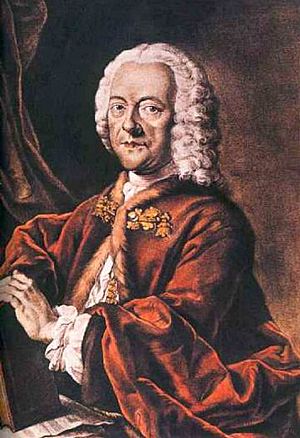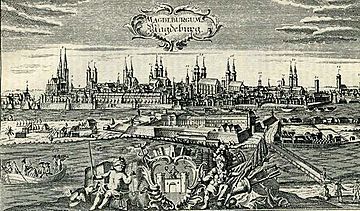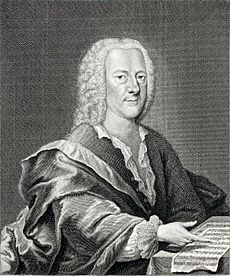Georg Philipp Telemann facts for kids
Quick facts for kids
Georg Philipp Telemann
|
|
|---|---|

A picture of Telemann from 1750
|
|
| Born | 24 March [O.S. 14 March] 1681 Magdeburg, Duchy of Magdeburg, Electorate of Brandenburg
|
| Died | 25 June 1767 (aged 86) Free and Imperial City of Hamburg, Holy Roman Empire
|
| Education | Leipzig University |
| Occupation |
|
Georg Philipp Telemann (born March 24, 1681 – died June 25, 1767) was a German Baroque composer who played many instruments. He mostly taught himself music, even though his family didn't want him to be a musician.
Telemann studied in different cities like Magdeburg and Hildesheim. He later went to Leipzig University to study law, but he decided to become a musician instead. He worked in important cities like Leipzig, Eisenach, and Frankfurt. In 1721, he moved to Hamburg and became the music director for the city's five main churches.
Even though his music career was very successful, Telemann's personal life had some challenges. His first wife passed away less than two years after they got married. His second wife had serious money problems before she left him.
Telemann wrote a huge amount of music, more than almost any other composer in history! People at the time thought he was one of Germany's best composers. They often compared him to his friends Johann Sebastian Bach and George Frideric Handel. Bach even named his son, Carl Philipp Emanuel Bach, after Telemann.
Telemann's music combined styles from France, Italy, and Germany. He was even influenced by Polish folk music. He always kept up with new musical trends. His music is an important link between the older Baroque style and the newer Classical style. You can learn more about him at the Telemann Museum in Hamburg.
Contents
- Life of Georg Philipp Telemann
- Telemann's Impact on Music
- Some of Telemann's Works
- Operas
- Passions (Musical Stories of Jesus's Suffering)
- Cantatas (Vocal Pieces)
- Oratorios (Large Choral Works)
- Orchestral Suites (Collections of Dances)
- Chamber Music (Music for Small Groups)
- Keyboard Music
- Organ and Music Theory Works
- Concertos (Pieces for Solo Instrument(s) and Orchestra)
- Sonatas (Instrumental Pieces)
- Images for kids
- See also
Life of Georg Philipp Telemann
Early Years and Musical Start (1681–1712)
Telemann was born in Magdeburg, Germany. His father, Heinrich, passed away when Telemann was only four years old. When he was 10, Telemann started taking music lessons from a local organ player. He quickly became very interested in music and writing his own songs.
Even though his mother and other family members didn't want him to pursue music, Telemann secretly studied and composed. He even wrote an opera when he was just 12!
In 1697, after studying in Magdeburg and Zellerfeld, Telemann went to a famous school in Hildesheim. There, his musical talent really grew, and the school supported him. Telemann became good at both composing and playing many instruments. He taught himself to play the flute, oboe, violin, and many others.
In 1701, he finished school and went to Leipzig University to study law. But he ended up becoming a professional musician. He regularly wrote music for churches like Nikolaikirche and St. Thomas (Thomaskirche). In 1702, he became the director of the city's opera house. He also became the music director at another church.
Telemann was incredibly productive in Leipzig. He created a lot of new music, including several operas. One of his first big operas was Germanicus. However, he had some disagreements with Johann Kuhnau, who was the music director at the Thomaskirche. The problems grew when Telemann started hiring many students for his projects, including some who worked for Kuhnau.
In 1705, when he was 24, Telemann left Leipzig. He was invited to become the music director for Count Erdmann II of Promnitz in Sorau (now Żary, Poland). His time there was cut short in 1706 because of a war. After traveling for a bit, he started working for Duke Johann Wilhelm in Eisenach. This is the city where Johann Sebastian Bach was born.
Telemann became a lead musician in Eisenach in 1708 and then the main music director in 1709. During his time there, he wrote a lot of music. This included church songs, sonatas, and concertos. In 1709, he married Amalie Louise Juliane Eberlin. She was the daughter of a musician. Their daughter was born in January 1711, but Amalie passed away soon after. This made Telemann very sad.
Frankfurt Years (1712–1721)
After less than a year, Telemann looked for a new job. In 1712, at age 31, he moved to Frankfurt. He became the city's music director and the main musician at two major churches. In Frankfurt, he really developed his own unique musical style.
Just like in Leipzig, he was a very important person in Frankfurt's music scene. He created music for churches, city events, and various groups of musicians. By 1720, he started using the da capo aria in his operas. This was a popular style where a section of music is repeated. Operas like Narciso, which came to Frankfurt in 1719, influenced Telemann's work with their Italian style.
On August 28, 1714, three years after his first wife died, Telemann married again. His new wife was Maria Catharina Textor. They had nine children together. This brought him a lot of happiness and helped him compose even more music.
Telemann continued to be very productive and successful. He even earned extra money by sending new music to his old employers in Eisenach, even though he didn't live there anymore. Telemann also started publishing his music during his time in Frankfurt. He wrote many overture-suites and chamber music pieces. These included his 6 Sonatas for solo violin, known as the Frankfurt Sonatas, published in 1715. He also composed his Viola Concerto in G major, which was an innovative piece. In 1716, he wrote his first big choral work, the Brockes Passion.
Hamburg and Later Life (1721–1767)
In 1721, Telemann accepted a job in Hamburg. He became the music teacher at the Johanneum school and the music director for the five biggest churches. Soon after he arrived, some church officials had concerns. They felt his non-religious music and activities were too distracting for him and the people of the town.
The next year, when Johann Kuhnau died, the city of Leipzig was looking for a new music director. Telemann applied and was approved for the job. However, he decided to stay in Hamburg after the city agreed to give him a good raise. After another candidate, Christoph Graupner, also turned down the Leipzig job, it went to Johann Sebastian Bach.
Telemann took a few short trips outside Germany during this time. Later, in 1737 and 1738, he traveled to Paris and stayed for eight months. He was very impressed by Castor et Pollux, an opera by the French composer Jean-Philippe Rameau. From then on, he started adding French opera styles to his vocal music. Before this, his music was mostly influenced by Italian and German styles.
Other than that trip, Telemann stayed in Hamburg for the rest of his life. A great vocal piece from this time is his St Luke Passion from 1728. This shows his fully developed vocal style.
His first years in Hamburg were difficult because of his wife's money problems. Her debts were even larger than Telemann's yearly income. His friends helped him avoid going bankrupt. He also published many successful music and poetry works between 1725 and 1740, which helped him financially. By 1736, he and his wife were no longer living together because of their financial disagreements.
Even though he was still active and busy with his job, Telemann composed less in the 1740s, when he was in his 60s. He started studying music theory and enjoyed hobbies like gardening and growing unusual plants. This was a popular hobby in Hamburg at the time, and Handel also enjoyed it.
Most of the music he wrote in the 1750s seemed to reuse parts from his earlier works. Telemann's oldest son, Andreas, passed away in 1755. Andreas's son, Georg Michael Telemann, was then raised by the aging composer.
In his final years, Telemann had health problems and his eyesight was failing. But he was still composing into the 1760s. He passed away on June 25, 1767, from what was called a "chest ailment." His godson, Johann Sebastian Bach's second son Carl Philipp Emanuel Bach, took over his job in Hamburg.
Telemann's Impact on Music
Telemann was one of the most productive composers ever. He wrote more than 3,000 pieces of music! Sadly, about half of them have been lost, and most haven't been played since the 1700s. From 1708 to 1750, Telemann composed over 1,000 church songs and 600 orchestral suites. He also wrote concertos for instrument combinations that no other composer used at the time.
Music experts only figured out the true number of his works in the 1980s and 1990s. This was when detailed lists of his music were published. During his lifetime, and for a while after, Telemann was highly respected by other musicians and critics. Many music theorists used his works as examples of great music. Famous composers like J.S. Bach and Handel even bought and studied his published pieces.
He was very popular not just in Germany, but all over Europe. People from France, Italy, the Netherlands, and other countries ordered his music. However, in the early 1800s, his popularity suddenly stopped. Many music writers started saying he wrote too much, and that quantity was more important to him than quality.
After people rediscovered Bach's music, Telemann's works were sometimes seen as not as good as Bach's. For example, in 1911, the Encyclopædia Britannica didn't even have an article about Telemann. It only mentioned him as a "vastly inferior" composer compared to Handel and Bach.
Some famous writers about Bach, like Philipp Spitta and Albert Schweitzer, even criticized Telemann's church songs. They then praised other works they thought were by Bach, but were actually by Telemann! The last major performance of Telemann's music happened in 1832. It wasn't until the 1900s that his music started to be performed again.
Interest in Telemann began to grow in the early 1900s. It really took off in the 1950s when a special collection of his works was published. Today, each of Telemann's works is given a TWV number. This stands for Telemann-Werke-Verzeichnis, which means "Telemann Works Catalogue."
Telemann's music was very important in the shift from the late Baroque to the early Classical styles. In the 1710s, he helped create a "German mixed style." This was a blend of German, French, Italian, and Polish musical styles. Over the years, his music changed and started to include more elements of the galant style, which was lighter and simpler. However, he never fully adopted the new Classical style. Telemann's music remained complex in its harmonies and counterpoint. In fact, in 1751, he said that much of the new music was too simple.
Composers he influenced included Bach's students in Leipzig, like Wilhelm Friedemann Bach and Carl Philipp Emanuel Bach. He also influenced composers who performed under his direction, like Christoph Graupner. Many of his own students were also influenced by him.
Telemann's work in publishing music was also very important. He fought for the exclusive right to publish his own works. This helped set an important early example for treating music as the composer's own intellectual property. He also performed music in public concerts that was originally written for private events for the upper class.
Some of Telemann's Works
Operas
Passions (Musical Stories of Jesus's Suffering)
- Georg Philipp Telemann's Passions
Cantatas (Vocal Pieces)
- Cantata Cycle 1716–1717
- Harmonischer Gottes-Dienst
- Die Donner-Ode ("The Ode of Thunder")
- Ino (1765)
- Die Tageszeiten ("The Times of the Day") (1757)
Oratorios (Large Choral Works)
- Hamburger Admiralitätsmusik (Music for the Hamburg Admiralty)
- Der Tag des Gerichts (The Day of Judgement) (1761–62)
- Hamburgische Kapitänsmusik (Music for Hamburg Captains)
- Der Tod Jesu (The Death of Jesus) (1755)
- Die Auferstehung und Himmelfahrt Jesu" (The Resurrection and Ascension of Jesus) (1760)
- Der aus der Löwengrube errettete Daniel ("Daniel Delivered from the Lion's Den") (1731)
Orchestral Suites (Collections of Dances)
- Grillen-symphonie
- Ouverture (Wassermusik: Hamburger Ebb und Fluth) (Water Music: Hamburg Ebb and Flow)
- Ouverture des nations anciens et modernes (Overture of Ancient and Modern Nations)
- Suite in A minor for recorder, strings, and continuo
- Overture: Alster Echo in F, for 4 horns, 2 oboes, bassoon, strings and continuo,
Chamber Music (Music for Small Groups)
- Sinfonia Spirituosa in D major (for 2 violins, viola & continuo, with trumpet optional)
- Tafelmusik (1733) (This means 'table music,' meant to be played during a meal)
- Der getreue Musikmeister (1728), a music magazine with 70 small songs and instrumental pieces
- Twelve Paris quartets in two sets (for flute, violin, viola da gamba or cello, and continuo)
- Twelve Fantasias for Flute without Bass
- Twelve Fantasias for Violin without Bass
- Twelve Fantasias for Viola da Gamba solo
- Six Canonical Sonatas
- Six Concertos for Flute and Harpsichord
Keyboard Music
- 36 Fantasias for Keyboard
- 6 Overtures for Keyboard
- 6 Light Fugues with Small Fresh Additions
Organ and Music Theory Works
- 48 Chorale Preludes for Organ
- 20 Easy Fugues in 4 parts
- 500 chorale harmonizations
Concertos (Pieces for Solo Instrument(s) and Orchestra)
Violin Concertos
- Violin Concerto in A major "Die Relinge"
- Concerto for Three Violins in F major
- Four Concertos for Four Violins
Viola Concertos
- Concerto in G major for Viola and String Orchestra; this is the first known concerto for viola and is still played often today.
- Concerto in G major for Two Violas and String Orchestra
Horn Concertos
- Concerto for Two Horns in D major
- Concerto for Horn and Orchestra in D major
- Concerto for Three Horns in D and Violin
Trumpet Concertos
- Trumpet Concerto in D major
- Concerto in D for Trumpet and 2 Oboes
- Concerto in D for Trumpet, Violin and Cello
- Concerto in D for 3 Trumpets, Timpani, 2 Oboes
Chalumeau Concertos
- Concerto in C major for 2 Chalumeaux, 2 Bassoons and Orchestra
- Concerto in D minor for Two Chalumeaux and Orchestra
Oboe Concertos
- Concerto in A major
- Concerto in C minor
- Concerto in D minor
- Concerto in E minor
- Concerto in F minor
- Concerto in G major
Bassoon Concertos
- Concerto for Recorder and Bassoon in F major
Recorder Concertos
- Concerto in C major
- Concerto in F major
- Concerto for Recorder and Viola da gamba in A minor
- Concerto for 2 Recorders in A minor
- Concerto for 2 Recorders in B-flat major
Flute Concertos
- Concerto in D major
- Concerto in E minor for Recorder and Flute
- Concerto in B minor
- Concerto in C minor
Sonatas (Instrumental Pieces)
- Sonata da chiesa, TWV 41:g5 (for Violin, Flute or Oboe)
Oboe Sonatas
- Sonata in A minor
- Sonata in B-flat
- Sonata in E minor
- Sonata in G minor
Bassoon Sonatas
- Sonata in F minor
- Sonata in E-flat major
Images for kids
See also
 In Spanish: Georg Philipp Telemann para niños
In Spanish: Georg Philipp Telemann para niños




